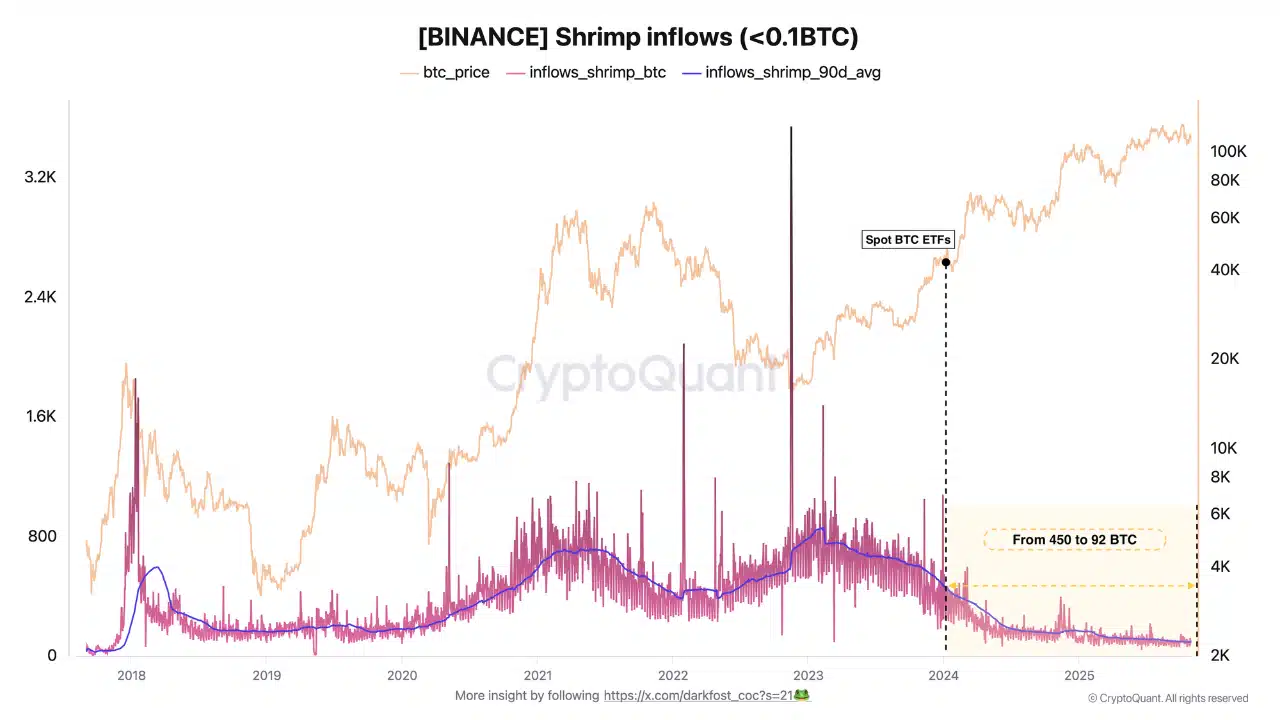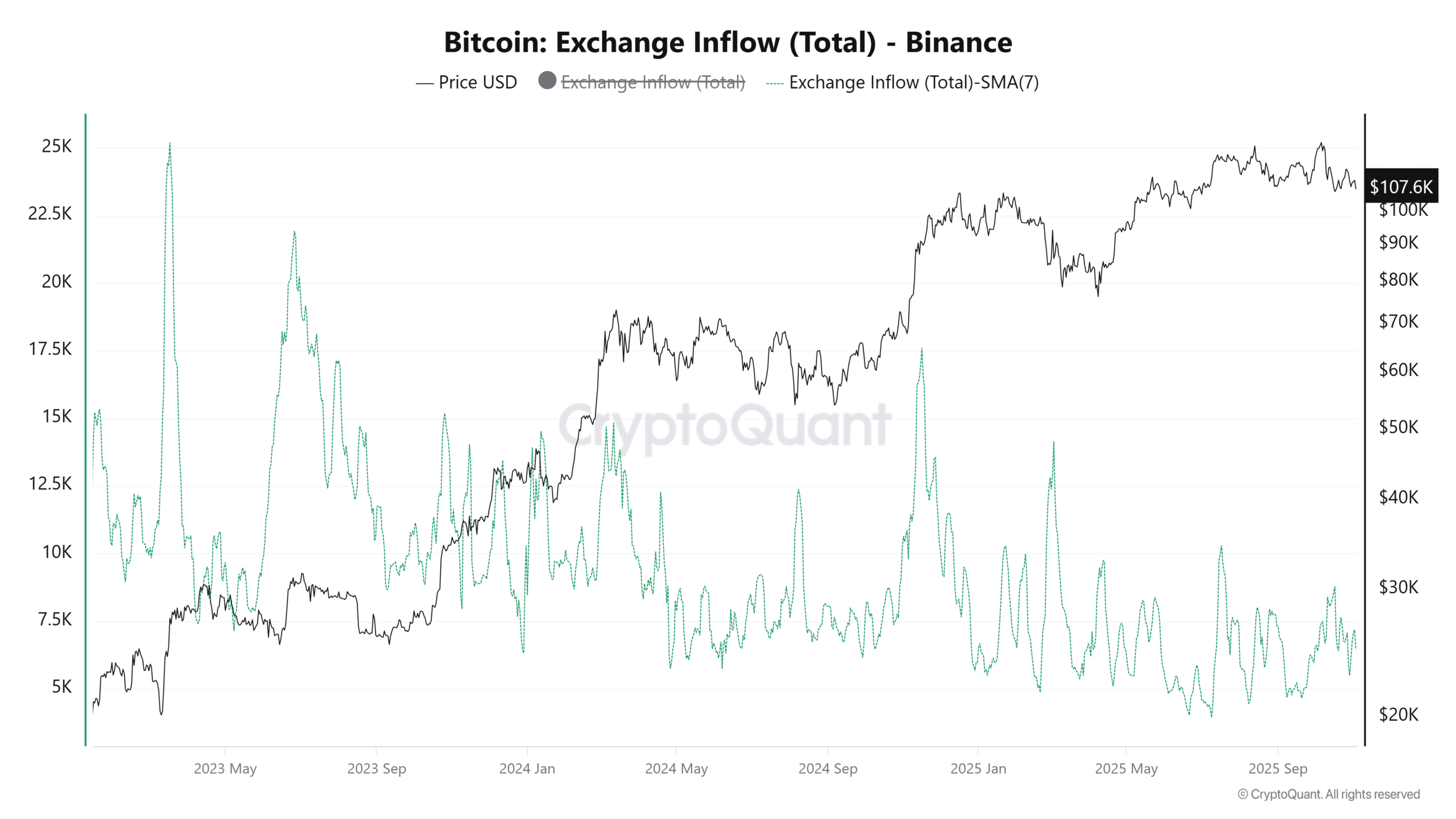| COINOTAG recommends • Exchange signup |
| 💹 Trade with pro tools |
| Fast execution, robust charts, clean risk controls. |
| 👉 Open account → |
| COINOTAG recommends • Exchange signup |
| 🚀 Smooth orders, clear control |
| Advanced order types and market depth in one view. |
| 👉 Create account → |
| COINOTAG recommends • Exchange signup |
| 📈 Clarity in volatile markets |
| Plan entries & exits, manage positions with discipline. |
| 👉 Sign up → |
| COINOTAG recommends • Exchange signup |
| ⚡ Speed, depth, reliability |
| Execute confidently when timing matters. |
| 👉 Open account → |
| COINOTAG recommends • Exchange signup |
| 🧭 A focused workflow for traders |
| Alerts, watchlists, and a repeatable process. |
| 👉 Get started → |
| COINOTAG recommends • Exchange signup |
| ✅ Data‑driven decisions |
| Focus on process—not noise. |
| 👉 Sign up → |
Bitcoin retail participation has declined sharply since the January 2024 ETF launch, with shrimp inflows to exchanges dropping from 450 BTC to just 92 BTC daily. This shift reflects investors preferring ETF exposure over direct on-chain activity, reducing small holder involvement while institutions dominate.
-
ETFs accelerated the drop in retail Bitcoin inflows post-2024 launch.
-
Shrimp addresses holding under 0.1 BTC have stalled, indicating less direct engagement from small investors.
-
Daily inflows now average 92 BTC from shrimps, compared to over 3,900 BTC overall, highlighting institutional control with 20% of prior levels.
Discover why Bitcoin retail participation is declining amid ETF dominance and on-chain shifts. Explore shrimp inflows data and institutional impacts for informed crypto insights—stay ahead of market trends today.
What is causing the decline in Bitcoin retail participation?
Bitcoin retail participation has significantly decreased following the introduction of spot Bitcoin ETFs in January 2024, as smaller investors increasingly opt for these regulated investment vehicles over direct cryptocurrency purchases and on-chain transactions. This trend is evident in on-chain metrics showing reduced inflows and address activity from retail holders, known as “shrimps” for their holdings under 0.1 BTC. While this shift streamlines access for newcomers, it marks a departure from Bitcoin’s original peer-to-peer ethos, with institutions now driving the majority of network flows.
| COINOTAG recommends • Professional traders group |
| 💎 Join a professional trading community |
| Work with senior traders, research‑backed setups, and risk‑first frameworks. |
| 👉 Join the group → |
| COINOTAG recommends • Professional traders group |
| 📊 Transparent performance, real process |
| Spot strategies with documented months of triple‑digit runs during strong trends; futures plans use defined R:R and sizing. |
| 👉 Get access → |
| COINOTAG recommends • Professional traders group |
| 🧭 Research → Plan → Execute |
| Daily levels, watchlists, and post‑trade reviews to build consistency. |
| 👉 Join now → |
| COINOTAG recommends • Professional traders group |
| 🛡️ Risk comes first |
| Sizing methods, invalidation rules, and R‑multiples baked into every plan. |
| 👉 Start today → |
| COINOTAG recommends • Professional traders group |
| 🧠 Learn the “why” behind each trade |
| Live breakdowns, playbooks, and framework‑first education. |
| 👉 Join the group → |
| COINOTAG recommends • Professional traders group |
| 🚀 Insider • APEX • INNER CIRCLE |
| Choose the depth you need—tools, coaching, and member rooms. |
| 👉 Explore tiers → |
How have shrimp inflows to exchanges changed since 2024?
The decline in shrimp inflows to major exchanges like Binance has been progressive, with the 90-day moving average revealing a stark reduction from approximately 450 BTC per day in early 2024 to just 92 BTC as of late 2025, according to analysis from CryptoQuant Insights. This data underscores how the ETF launch prompted retail investors to bypass direct Bitcoin acquisitions, favoring passive exposure through financial products instead. Supporting on-chain evidence from Glassnode further illustrates that the number of addresses holding at least 0.1 BTC peaked at 4.58 million in late 2023 before slipping to 4.44 million, signaling a slowdown in grassroots adoption. Experts note that this structural change has not disrupted Bitcoin’s overall ecosystem but has amplified institutional influence, with large-scale inflows dwarfing retail contributions by an order of magnitude—recent seven-day moving averages hitting 3,936 BTC even at lows.
Bitcoin [BTC] encountered renewed selling pressure on November 3, 2025, amid concerns of leverage unwinding and waning market sentiment. Earlier reports indicated this might signal the onset of a larger correction, yet stabilizing factors like accumulating stablecoin reserves could spark a recovery, positioning recent dips as potential bottoms. However, large-scale liquidations from the prior month have made new entrants cautious, exacerbating the retreat of smaller players from direct market involvement.
| COINOTAG recommends • Exchange signup |
| 📈 Clear interface, precise orders |
| Sharp entries & exits with actionable alerts. |
| 👉 Create free account → |
| COINOTAG recommends • Exchange signup |
| 🧠 Smarter tools. Better decisions. |
| Depth analytics and risk features in one view. |
| 👉 Sign up → |
| COINOTAG recommends • Exchange signup |
| 🎯 Take control of entries & exits |
| Set alerts, define stops, execute consistently. |
| 👉 Open account → |
| COINOTAG recommends • Exchange signup |
| 🛠️ From idea to execution |
| Turn setups into plans with practical order types. |
| 👉 Join now → |
| COINOTAG recommends • Exchange signup |
| 📋 Trade your plan |
| Watchlists and routing that support focus. |
| 👉 Get started → |
| COINOTAG recommends • Exchange signup |
| 📊 Precision without the noise |
| Data‑first workflows for active traders. |
| 👉 Sign up → |
Charting the Bitcoin inflows from retail investors
The erosion of retail engagement in Bitcoin has unfolded gradually rather than abruptly. Insights from CryptoQuant highlight that inflows from shrimp investors now represent only about 20% of early 2024 levels, a trend that intensified after the spot ETF approvals. These ETFs provided a familiar, low-friction entry point for traditional investors, diverting flows away from exchanges and personal wallets.

| COINOTAG recommends • Traders club |
| ⚡ Futures with discipline |
| Defined R:R, pre‑set invalidation, execution checklists. |
| 👉 Join the club → |
| COINOTAG recommends • Traders club |
| 🎯 Spot strategies that compound |
| Momentum & accumulation frameworks managed with clear risk. |
| 👉 Get access → |
| COINOTAG recommends • Traders club |
| 🏛️ APEX tier for serious traders |
| Deep dives, analyst Q&A, and accountability sprints. |
| 👉 Explore APEX → |
| COINOTAG recommends • Traders club |
| 📈 Real‑time market structure |
| Key levels, liquidity zones, and actionable context. |
| 👉 Join now → |
| COINOTAG recommends • Traders club |
| 🔔 Smart alerts, not noise |
| Context‑rich notifications tied to plans and risk—never hype. |
| 👉 Get access → |
| COINOTAG recommends • Traders club |
| 🤝 Peer review & coaching |
| Hands‑on feedback that sharpens execution and risk control. |
| 👉 Join the club → |

Source: CryptoQuant Insights
This pivot aligns with broader patterns where retail activity diminished even during price surges, as investors found ETF shares more accessible than navigating crypto exchanges. The result is a more mature but less decentralized participation model.
Shrimp addresses hit slowdown
Examination of address metrics reinforces the narrative of retail disengagement. After a robust expansion through 2022 and into 2023, the growth in shrimp addresses has plateaued, per Glassnode data. This stagnation points to a preference for indirect ownership, where ETFs handle custody and trading, reducing the need for personal Bitcoin management.
| COINOTAG recommends • Exchange signup |
| 📈 Clear control for futures |
| Sizing, stops, and scenario planning tools. |
| 👉 Open futures account → |
| COINOTAG recommends • Exchange signup |
| 🧩 Structure your futures trades |
| Define entries & exits with advanced orders. |
| 👉 Sign up → |
| COINOTAG recommends • Exchange signup |
| 🛡️ Control volatility |
| Automate alerts and manage positions with discipline. |
| 👉 Get started → |
| COINOTAG recommends • Exchange signup |
| ⚙️ Execution you can rely on |
| Fast routing and meaningful depth insights. |
| 👉 Create account → |
| COINOTAG recommends • Exchange signup |
| 📒 Plan. Execute. Review. |
| Frameworks for consistent decision‑making. |
| 👉 Join now → |
| COINOTAG recommends • Exchange signup |
| 🧩 Choose clarity over complexity |
| Actionable, pro‑grade tools—no fluff. |
| 👉 Open account → |


| COINOTAG recommends • Members‑only research |
| 📌 Curated setups, clearly explained |
| Entry, invalidation, targets, and R:R defined before execution. |
| 👉 Get access → |
| COINOTAG recommends • Members‑only research |
| 🧠 Data‑led decision making |
| Technical + flow + context synthesized into actionable plans. |
| 👉 Join now → |
| COINOTAG recommends • Members‑only research |
| 🧱 Consistency over hype |
| Repeatable rules, realistic expectations, and a calmer mindset. |
| 👉 Get access → |
| COINOTAG recommends • Members‑only research |
| 🕒 Patience is an edge |
| Wait for confirmation and manage risk with checklists. |
| 👉 Join now → |
| COINOTAG recommends • Members‑only research |
| 💼 Professional mentorship |
| Guidance from seasoned traders and structured feedback loops. |
| 👉 Get access → |
| COINOTAG recommends • Members‑only research |
| 🧮 Track • Review • Improve |
| Documented PnL tracking and post‑mortems to accelerate learning. |
| 👉 Join now → |
Source: Glassnode
Such developments suggest that while Bitcoin’s price remains resilient, the composition of its user base is evolving toward greater institutional reliance, potentially influencing long-term network dynamics.
| COINOTAG recommends • Exchange signup |
| 🎯 Focus on process over noise |
| Plan trades, size positions, execute consistently. |
| 👉 Sign up → |
| COINOTAG recommends • Exchange signup |
| 🛠️ Simplify execution |
| Keep decisions clear with practical controls. |
| 👉 Get started → |
| COINOTAG recommends • Exchange signup |
| 📊 Make data your edge |
| Use depth and alerts to avoid guesswork. |
| 👉 Open account → |
| COINOTAG recommends • Exchange signup |
| 🧭 Be prepared, not reactive |
| Turn setups into rules before you trade. |
| 👉 Create account → |
| COINOTAG recommends • Exchange signup |
| ✍️ Plan first, then act |
| Entries, exits, and reviews that fit your routine. |
| 👉 Join now → |
| COINOTAG recommends • Exchange signup |
| 🧩 Consistency beats intensity |
| Small, repeatable steps win the long run. |
| 👉 Sign up → |
Shrimp impact fades as institutions rise
The diminished role of shrimp investors appears to have minimal bearing on Bitcoin’s market trajectory. Exchange inflow data from CryptoQuant shows that even at its 2025 nadir, the seven-day moving average for total BTC inflows to Binance reached 3,936 BTC—far exceeding shrimp contributions from prior years.

| COINOTAG recommends • Premium trading community |
| 🏛️ WAGMI CAPITAL — Premium Trading Community |
| Strategic insights, exclusive opportunities, professional support. |
| 👉 Join WAGMI CAPITAL → |
| COINOTAG recommends • Premium trading community |
| 💬 Inner Circle access |
| See members share real‑time PnL and execution notes in chat. |
| 👉 Apply for Inner Circle → |
| COINOTAG recommends • Premium trading community |
| 🧩 Turn theses into trades |
| Reusable templates for entries, risk, and review—end to end. |
| 👉 Join the club → |
| COINOTAG recommends • Premium trading community |
| 💡 Long‑term mindset |
| Patience and discipline over noise; a process that compounds. |
| 👉 Get started → |
| COINOTAG recommends • Premium trading community |
| 📚 Education + execution |
| Courses, playbooks, and live market walkthroughs—learn by doing. |
| 👉 Get access → |
| COINOTAG recommends • Premium trading community |
| 🔒 Members‑only research drops |
| Curated analyses and private briefings—quality over quantity. |
| 👉 Join WAGMI CAPITAL → |

Source: CryptoQuant
| COINOTAG recommends • Exchange signup |
| 🧱 Execute with discipline |
| Watchlists, alerts, and flexible order control. |
| 👉 Sign up → |
| COINOTAG recommends • Exchange signup |
| 🧩 Keep your strategy simple |
| Clear rules and repeatable steps. |
| 👉 Open account → |
| COINOTAG recommends • Exchange signup |
| 🧠 Stay objective |
| Let data—not emotion—drive actions. |
| 👉 Get started → |
| COINOTAG recommends • Exchange signup |
| ⏱️ Trade when it makes sense |
| Your plan sets the timing—not the feed. |
| 👉 Join now → |
| COINOTAG recommends • Exchange signup |
| 🌿 A calm plan for busy markets |
| Set size and stops first, then execute. |
| 👉 Create account → |
| COINOTAG recommends • Exchange signup |
| 🧱 Your framework. Your rules. |
| Design entries/exits that fit your routine. |
| 👉 Sign up → |
Institutional players and ETF mechanisms have redefined market participation, rendering small transactions less influential. This evolution strays from Bitcoin’s foundational concept as a decentralized electronic cash system envisioned by its creator, yet the asset persists as a store of value, adapting to new realities.
Analysts from platforms like CryptoQuant emphasize that while retail flows wane, Bitcoin’s fundamentals remain intact, supported by growing corporate and sovereign interest. The ETF influx, exceeding billions in assets under management, has injected stability, though it raises questions about centralization risks in custody and trading.
Looking at historical parallels, similar shifts occurred during the 2021 bull run when institutional entry via futures contracts began sidelining pure retail speculation. Today, this pattern is amplified, with on-chain volume from whales and institutions comprising over 80% of exchange movements. Data from Glassnode corroborates that accumulation by addresses holding 1-10 BTC has offset retail declines, maintaining network health.
For investors, this means monitoring broader metrics like ETF net creations alongside traditional indicators. The reduced shrimp activity could signal maturing markets but also highlights the need for education on direct ownership benefits versus proxy investments.
Frequently Asked Questions
Why did Bitcoin shrimp inflows drop after the 2024 ETF launch?
The spot Bitcoin ETF approvals in January 2024 simplified access for retail investors, leading them to purchase shares through brokerage accounts rather than buying BTC directly on exchanges. This resulted in a 80% plunge in shrimp inflows over 90 days, from 450 BTC to 92 BTC daily, as per CryptoQuant data, reflecting a preference for regulated products over on-chain involvement.
What impact does declining retail participation have on Bitcoin’s price?
Declining retail participation in Bitcoin has limited direct effects on price trends, as institutional inflows via ETFs and large entities now dominate trading volumes. While it reduces short-term volatility from small trades, it underscores a shift toward professional management, potentially stabilizing prices through sustained demand from bigger players, according to on-chain analyses from Glassnode.
Key Takeaways
- ETFs as a catalyst: The January 2024 launch diverted retail flows, cutting shrimp inflows to 20% of prior levels and promoting indirect exposure.
- Address stagnation: Shrimp holdings under 0.1 BTC have declined from 4.58 million to 4.44 million addresses, per Glassnode, signaling less grassroots activity.
- Institutional shift: Total exchange inflows remain robust at over 3,900 BTC daily, emphasizing the rising dominance of large investors and the evolving Bitcoin ecosystem.
Conclusion
The decline in Bitcoin retail participation and shrimp inflows marks a pivotal evolution driven by ETF accessibility and institutional growth, reshaping how investors engage with the asset. As on-chain data from CryptoQuant and Glassnode illustrates, this trend enhances market maturity without undermining Bitcoin’s core value proposition. Looking ahead, stakeholders should balance proxy investments with direct holdings to align with the network’s decentralized roots—explore further strategies to navigate this transforming landscape.
| COINOTAG recommends • Members‑only research |
| 📌 Curated setups, clearly explained |
| Entry, invalidation, targets, and R:R defined before execution. |
| 👉 Get access → |
| COINOTAG recommends • Members‑only research |
| 🧠 Data‑led decision making |
| Technical + flow + context synthesized into actionable plans. |
| 👉 Join now → |
| COINOTAG recommends • Members‑only research |
| 🧱 Consistency over hype |
| Repeatable rules, realistic expectations, and a calmer mindset. |
| 👉 Get access → |
| COINOTAG recommends • Members‑only research |
| 🕒 Patience is an edge |
| Wait for confirmation and manage risk with checklists. |
| 👉 Join now → |
| COINOTAG recommends • Members‑only research |
| 💼 Professional mentorship |
| Guidance from seasoned traders and structured feedback loops. |
| 👉 Get access → |
| COINOTAG recommends • Members‑only research |
| 🧮 Track • Review • Improve |
| Documented PnL tracking and post‑mortems to accelerate learning. |
| 👉 Join now → |













